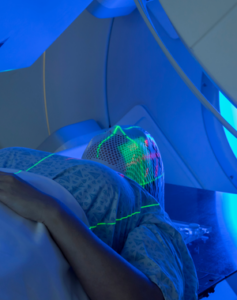MEDVIA-funded project eFlash2D is working to ensure that dosimetry is ready when flash radiation enters clinical trials
Flash radiation has the potential to become a revolution in radiation therapy. A treatment that promises to limit the damage to surrounding healthy tissue, it is currently in the pre-clinical stage.
At the same time, the MEDVIA-funded project eFlash2D will ensure that dosing is ready for the next step. Radiation dosimetry is crucial in cancer therapy, and is – quite literally – a thousand times more challenging when it comes to flash radiation.
“At least 50% of cancer patients will get radiotherapy at some stage of the treatment,” says Dr Luana de Freitas Nascimento, a senior researcher at the SCK CEN nuclear research center in Mol. “When you administer that therapy, you risk irradiating surrounding healthy tissue, and that is a huge problem.”
From one minute to microseconds
Aside from radiation burns on the skin’s surface, damaged cells near the tumor can mutate and become cancerous themselves later on. It can happen to anyone but is a major issue for pediatric patients, explains Luana. “If you treat a five-year-old, you can cause a tumor to appear 20 years later.”
So limiting the damage done to healthy cells is crucial. Flash radiation has the potential to significantly limit this damage.
Currently, one dose of radiotherapy – whether photon, electron or proton – is administered for 30 seconds to up to several minutes over the course of some 30 sessions. The treatments are spread over several weeks to, again, save healthy tissue from mutating. Healthy cells, which regenerate faster than tumorous cells, have some time to heal between sessions.
Flash radiation takes that potentially minutes-long treatment down to a few milliseconds – a thousandth of a second. This could considerably cut down the number of sessions needed. “We aren’t sure yet, but we have scientific indications that the tumors will be impacted the same way,” says Luana, “while the healthy tissue will barely be effected. From what we have seen so far, we are cautiously optimistic.”
Time machine
So what does this have to do with dosimetry? Radiation doses must be measured independently to ensure that the accelerator is emitting what you think it is emitting. “If the machine shows an amount of dose, but it’s really giving less or more, it’s either not treating the patient or it’s going to kill the patient. We never trust the machine. eFlash2D will be able to measure the dose of radiation that comes out of that machine.”
The dosimetry project is being carried out by a consortium made up of SCK CEN, Agfa, the GZA coalition of hospitals in Antwerp and Antwerp University Hospital. It has the potential to be groundbreaking because, while dosimetry exists for radiotherapy currently being used, it does not exist for flash radiation therapy. “No one has ever developed a dosimeter to measure that kind of time scale,” explains Luana.
While that part of the project will measure the dose so that accelerators can be calibrated, a second part of the project is developing the tech to measure the dose that actually hits the tumor. “Even if the machine is delivering precisely what you want, we have to make sure it’s in the right place. If the patient moves a bit, the beam hits the wrong place. For this, we need something that measures in real time so we can stop it if something is wrong.”
Real-time dosimetry also calculates what part of the dose is landing somewhere else based on simple physics. Luana: “A beam is a 3D delivery, and it’s reaching the surface, but you have a depth that this radiation is traveling through. If some of travels through the patient and hits the table, your physics dose is the same, but your biological dose is not.”
No trial without dosimetry
Lack of dosimetry technology hampers pre-clinical trials and even makes them meaningless. “Otherwise they don’t know how much dose they are giving to that mouse. You cannot be sure you are actually studying the flash effect if you don’t have the physics.”
The real-time dosimetry part of the project is pioneering as there is currently no commercially available product that measure the dose the patient is receiving in real time – not even in conventional therapy. Agfa develops imaging systems and technology and are working together with SCK CEN and KU Leuven on a separate project to produce this technology. Flash is going one step further.
“They thought maybe they could use the same machine calibration system with flash. That’s why SCK, the hospitals and Agfa came together in this project. We thought, we know what is necessary to change and what aspects we have to measure to go to flash. We have the know-how. So we decided then to apply for the funding.”
Ultimately, the 18-month project should lead to a product for the market, though there is much to be done first. “We won’t have a product in 18 months, but we will have a direction towards that product. We still have a lot of parameters to study.”
eFlash2D project in short:
Development of dosimetry for flash radiotherapy applications
Consortium: SCK CEN, GZA Ziekenhuizen, Antwerp University Hospital (UZA), Agfa
Timeline: Result of first call for MEDVIA funding (2021.1), start date 01/01/2022, 18-month duration
Total project budget: €366,600
Funding provided by MEDVIA: €183,300
Posted on 27 March 2023
Written by Lisa Bradshaw



